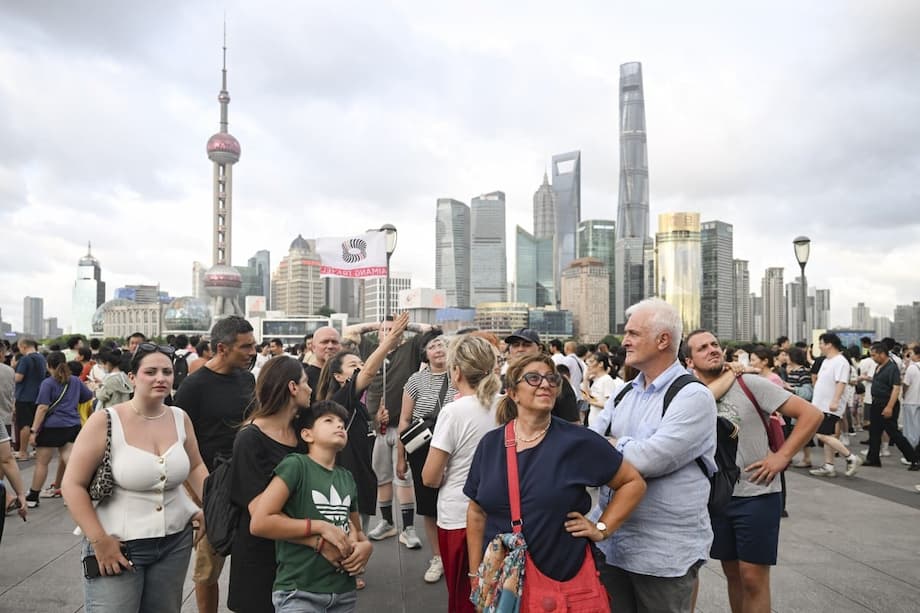Visa free entries surge as Southeast Asia leads the rebound
China recorded a strong rebound in inbound travel this year, led by a wave of visa free arrivals from Southeast Asia. According to the National Immigration Administration (NIA), foreign nationals made about 15.89 million visa free entries in the first eight months. Visa free entries accounted for roughly two thirds of all international arrivals over that period, which places total inbound entries at more than 25 million. The figures signal a decisive shift in China’s reopening, as visitors take advantage of easier entry rules and a growing web of mutual waivers across the region.
- Visa free entries surge as Southeast Asia leads the rebound
- Why Southeast Asia is powering the rebound
- A shift in visa policy, from transit waivers to deep reciprocity
- Russia added to the list as 30 day stays begin
- Economic stakes, who benefits and where
- Two way travel with Southeast Asia accelerates
- Barriers that still hold back a full recovery
- What to watch next
- Key Points
Travelers from the Association of Southeast Asian Nations are central to that upswing. NIA data indicates nationals from Southeast Asian countries made more than 9 million visa free trips to China in the first eight months, a large share of the 10.74 million total entries from those nations. Proximity, dense air links, and expanding business and cultural ties are helping restore flows that were curtailed during the pandemic years.
Policy changes are driving the momentum. China has rolled out a mix of unilateral visa exemptions and mutual waivers with key partners alongside its 144 hour transit without visa program in several cities. A milestone this summer was the reciprocal visa waiver with Malaysia that took effect on July 17. In the weeks since, Malaysian passport holders made around 180,000 trips to China, about 150,000 of them visa free. Agreements with Singapore and Thailand earlier in the year, as well as existing arrangements with Brunei, also support the rapid return of Southeast Asian travelers.
Officials expect the circle of visa free arrivals to widen beyond Southeast Asia. Russia is emerging as another important source, with a new policy that allows Russian citizens to stay in China for up to 30 days without a visa. Early border data suggests enthusiastic uptake, especially in northeastern provinces that host major land and air crossings.
The rebound is not just about leisure. Business travel, family visits, education, and short stopovers tied to the transit program are contributing to steady growth. With arrivals still below 2019 levels, authorities are layering policy upgrades with operational improvements at airports and land checkpoints to keep queues short and procedures predictable.
Why Southeast Asia is powering the rebound
The scale of Southeast Asia’s return reflects the region’s deep ties with China. Short flights connect dozens of city pairs. Many travelers visit family, source goods, or attend trade shows. Younger visitors combine city breaks in places like Shanghai and Shenzhen with cultural trips to Xi’an or Guilin. Visa waivers lower planning barriers and cut costs, which matters for short notice trips and regional weekend travel.
The Malaysia effect
Malaysia’s new mutual visa exemption with China has delivered an immediate lift. Since mid July, Malaysians have made about 180,000 trips to China and about 150,000 of those did not require a visa. The trend mirrors Malaysia’s own policy of welcoming Chinese visitors visa free, part of a strategy to support two way tourism and trade in a challenging global economy. More flights, bundled travel offers, and strong family and business networks between Malaysian cities and Chinese hubs suggest continued growth through peak travel seasons.
Thailand and Singapore drive momentum
Mutual visa exemption with Thailand began earlier in the year, and a 30 day mutual waiver with Singapore took effect in February. Both measures removed a major friction point in two of the region’s busiest travel corridors. Tour operators report healthier load factors on routes from Bangkok and Singapore to Shanghai, Guangzhou, and Chengdu. Business travel also benefits from flexibility, as team visits and supplier audits no longer hinge on pre arranged visa paperwork.
A shift in visa policy, from transit waivers to deep reciprocity
China’s current approach mixes three tools. First, mutual waivers with partners that agree to equal treatment, usually allowing short stays. Second, unilateral exemptions extended by China to selected countries for a defined period. Third, a 144 hour transit without visa program in major gateways that permits short stopovers for travelers heading to a third country. Each tool targets convenience and cost. Together, they create a ladder of options that covers everything from quick business visits to week long holidays.
Officials have paired policy with capacity. Border inspection agencies have opened more channels during peak hours, and airports are adding multilingual signage and service counters. The goal is to turn policy announcements into smooth arrivals at the checkpoint.
The National Immigration Administration has framed the uptick as the product of a broader opening policy. In a recent statement, the agency described how expanded facilitation measures are supporting sustained growth in cross border movement.
“The sustained growth in port entries and exits is a direct result of China’s continuous expansion of opening up,” the National Immigration Administration said.
Russia added to the list as 30 day stays begin
Russia’s inclusion marks a new phase. From this week, Russian visitors can stay in China for up to 30 days without a visa. Local border inspection authorities in Heilongjiang province reported more than 1,000 Russian entries on day one of the policy, with the vast majority arriving visa free. The change replaces a narrower allowance introduced in late 2023 that permitted visa free transit of up to 10 days only when traveling onward to a third country.
The policy is likely to lift travel between Russia’s Far East and northern Chinese cities such as Harbin, Heihe, and Suifenhe. Winter festivals, cross border shopping, and medical tourism could all benefit from easier short stays. Airlines and rail operators are expected to adjust schedules and capacity if demand holds through the winter peak.
Economic stakes, who benefits and where
Inbound visitors spend on hotels, restaurants, urban transport, entertainment, and retail. Travel also supports entry level jobs and gigs across the visitor economy, from guides and drivers to seasonal event staff. A steady flow of business travelers can have outsized effects by reinforcing supplier visits, trade fairs, and investment prospecting trips. The timing is helpful, since services have resumed growth faster than some other parts of the economy.
Policymakers must avoid growing pains that erode the visitor experience. Popular sites can attract large crowds on weekends and holidays. Major destinations are investing in digital ticketing, timed entry, and better last mile transport to smooth peaks. Transit friendly airports and upgraded checkpoints also matter for travelers who mix business and leisure across multiple cities.
The most resilient growth will likely come from hubs that are easy to enter, easy to navigate, and well connected to surrounding regions. Cities that combine international flights with high speed rail onward to heritage sites or coastal resorts stand to benefit the most. Local tourism boards are moving to curate neighborhood experiences, food markets, and cultural programming that extend visitor stays by a night or two.
Two way travel with Southeast Asia accelerates
The surge in inbound travel from Southeast Asia is part of a broader two way exchange. Chinese travelers returned to the region in force after restrictions eased. During the Lunar New Year holiday, bookings to Singapore, Thailand, and Malaysia rose above pre pandemic levels, and spending through digital wallets also increased. More direct routes and coordinated promotion campaigns helped lift demand for city breaks and beach escapes across Southeast Asia.
Competition to attract Chinese visitors is reshaping the region. Malaysia rose to the top of Southeast Asia’s tourism rankings in early 2025, helped by relaxed entry rules and major marketing pushes. Vietnam drew more Chinese visitors than Thailand in the first quarter, reflecting gains from new routes, affordability, and targeted promotion. Those same policies, in reverse, are now feeding a rise in Southeast Asian arrivals to China. Easier entry on both sides increases the number of feasible weekend trips and encourages repeat visits for events, trade shows, and medical services.
Barriers that still hold back a full recovery
Inbound travel has not yet reached the highs seen before the pandemic. Official tallies place foreign arrivals last year at about 26.9 million, compared with 31.9 million in 2019. Airlines are building back capacity, but some long haul markets still face thinner schedules. Geopolitical frictions and visa requirements for major markets like the United States add planning steps for many potential visitors.
Authorities are working to reduce friction. China’s diplomatic missions in the United States and Canada have launched an online visa application system for the initial stage of the process, which reduces paperwork and consolidates document submission. China has also relaxed some documentary requirements for US travelers, such as proof of round trip tickets and hotel bookings. Beijing is backing people to people exchange with a plan to host 50,000 American students in the next five years.
Xie Feng, China’s ambassador to the United States, promoted the new digital application as part of a broader push to welcome more visitors. He highlighted convenience for applicants and the intention to make the travel experience smoother.
“The new system makes visas easier and trips smoother,” said Xie Feng, Chinese ambassador to the United States.
What to watch next
Winter holiday travel and spring festival peaks will test how well airports and border checkpoints handle higher volumes. Carriers are likely to adjust capacity on China Southeast Asia routes and expand service on Russia linked corridors if demand remains strong. Additional mutual waivers or unilateral exemptions may arrive as China evaluates the impact of current measures. Local tourism offices will keep curating city level experiences that diversify beyond the classic Beijing Shanghai Xi’an triangle.
Growth that pairs policy facilitation with reliable on the ground services should prove durable. The combination of short, affordable flights within Asia, expanded waivers, and rising confidence among travelers suggests the current visa free surge will remain a defining feature of China’s reopening cycle.
Key Points
- About 15.89 million foreign entries to China were visa free in the first eight months, roughly two thirds of all arrivals.
- Southeast Asian citizens made more than 9 million visa free trips, the majority of the region’s 10.74 million total entries to China.
- Malaysia’s reciprocal exemption that began on July 17 has already yielded about 150,000 visa free trips by Malaysians.
- Russia joined the list, with stays of up to 30 days now visa free and a strong first day at border checkpoints.
- China’s toolkit includes mutual waivers, unilateral exemptions, and a 144 hour transit without visa program in key cities.
- Inbound volumes are rising but still below 2019 levels, with airlines rebuilding capacity and long haul markets lagging.
- New online visa application steps for the United States and Canada aim to cut paperwork and speed processing.
- Two way travel with Southeast Asia is strengthening, as regional competitors court Chinese tourists and send more visitors to China.




